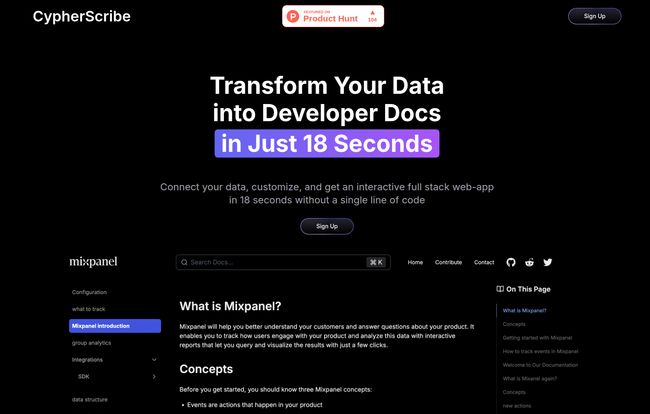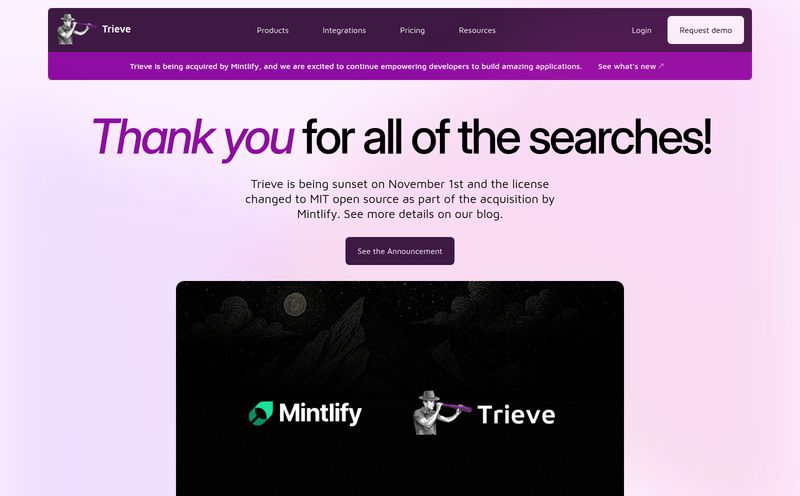If you've ever been on either side of an API, you know the soul-crushing pain of bad documentation. It’s either missing, outdated, or looks like a plain text file from 1997 that someone reluctantly uploaded via FTP. We’ve all been there, squinting at unformatted code blocks and praying for a single, useful example.
For years, creating beautiful, functional developer docs was a whole project in itself. You had to wrangle static site generators, fight with Markdown parsers, and beg a front-end dev for an hour of their time to make it not look terrible. It was a chore. A necessary evil.
So, when I saw a headline screaming, “Transform Your Data Into a Developer Doc in Just 18 Seconds,” my inner SEO and tech geek sat up straight. 18 seconds? That’s less time than it takes to brew a proper cup of coffee. The tool making this wild claim is CypherScribe. And naturally, I had to see if it was just marketing fluff or the real deal.

Visit CypherScribe
So, What Exactly is CypherScribe?
At its core, CypherScribe is a no-code platform designed specifically for creating developer documentation. Think of it as a Squarespace or Webflow, but hyper-focused on one thing: turning your data, API specs, or simple text into a fully interactive, searchable, and honestly, quite handsome developer portal. All without you needing to write a single line of CSS or JavaScript.
The whole premise is simplicity. You connect your data, you tweak the design with a user-friendly editor, and you launch. It handles the hosting, the rendering, and a bunch of the technical headaches that usually come with the territory.
The Need for Speed: Why '18 Seconds' Actually Matters
Okay, the 18-second claim is a fantastic hook. But beyond the wow factor, this speed is a fundamental shift in how we should think about documentation. In an agile world where products and APIs are updated weekly, or even daily, documentation can’t be an afterthought that takes two weeks to update. It needs to keep pace.
When you can refresh your entire docs site in seconds, it stops being a bottleneck. It becomes part of the development cycle, not a dreaded task you put off until the complaints roll in. Outdated docs kill developer experience (DX), and as any SaaS founder knows, poor DX is a leaky bucket for user retention. CypherScribe seems to tackle this problem head-on. It’s not just fast; it’s frictionless.
Breaking Down The Features That Caught My Eye
Speed is one thing, but a fast car with no engine is just a lawn ornament. I dug into the feature list to see if CypherScribe had the goods to back up its claims.
The No-Code Editor is a Huge Win
This is probably the biggest deal. For too long, documentation has been the exclusive domain of developers. With a no-code tool, product managers, technical writers, and even support leads can create and edit pages. It supports all the stuff you’d expect—headings, paragraphs, tables, code blocks, accordions, and media. This democratizes the process, freeing up valuable developer time for, you know, developing.
SEO and Search Built Right In? Yes, Please.
As an SEO guy, this made me giddy. Developer documentation is content! And it needs to be discoverable. How many times have you typed `"[some library] + how to do X"` into Google? Exactly. CypherScribe claims to provide industry-leading SEO tools and automated programmatic SEO. This is massive. It means your docs are more likely to rank for relevant queries, bringing in organic traffic from developers who are actively looking for solutions you provide. Plus, the built-in, fast search functionality within the docs themselves is a non-negotiable for any serious documentation portal.
Customization and That Little AI Helper
No one wants their documentation to look generic. CypherScribe gives you control over themes, branding, and most importantly, lets you use your own custom subdomain (like docs.your-company.com). This is critical for brand consistency and trust.
And then there's the AI Bot. The site mentions an "AI Bot that is trained on your data to help others navigate your documentation." This is a pretty modern touch. I imagine it as a super-powered search or an on-site chatbot that can answer questions like, "How do I authenticate my API key?" or "Show me an example of the user creation endpoint." If it works well, that's a powerful tool for improving user self-service.
Let's Talk Turkey: The CypherScribe Pricing Structure
Alright, the elephant in the room. What does this magic cost? The pricing is broken down into three straightforward tiers. It's not free, but it seems positioned to be a cost-effective alternative to building and maintaining a custom solution.
| Plan | Price | Best For | Key Limits |
|---|---|---|---|
| Starter | $45/month | Side projects or small products. | 1 Project, 50 Pages, 100k Requests/mo |
| Pro | $75/month | Growing teams and businesses. | 3 Projects, 200 Pages, 200k Requests/mo |
| Growth | $95/month | Companies looking to scale. | 5+ Projects, 500 Pages, 500k Requests/mo |
What's really impressive is that nearly all the core features—SEO tools, custom domains, SSL, fast support—are available on every single plan. They’re not locking essential features behind the most expensive tier, which is a practice I personally can't stand. You're mainly paying for more capacity as you grow. Fair enough.
My Honest Take: The Pros and Potential Pitfalls
No tool is perfect. After going through everything, here’s my balanced perspective.
The advantages are pretty clear. The speed is phenomenal, the no-code approach is liberating for teams, and the strong focus on SEO and search is a professional marketer's dream. Being able to create interactive, highly-customizable docs with AI assistance without a development team is a powerful proposition.
On the flip side, you are naturally dependent on the platform. You’re working within CypherScribe’s ecosystem, so you’re bound by the components and features they offer. For 95% of use cases, this is probably fine. But if you have an incredibly specific, esoteric need for a custom interactive widget they don’t support, you might hit a wall. There might also be a slight learning curve to master all the advanced customization options, but that's true of any powerful tool.
Frequently Asked Questions about CypherScribe
- Is any coding required to use CypherScribe?
- Nope. It’s a completely no-code platform. You can create, customize, and launch your documentation without writing code, though you'll obviously be adding your own code snippets into the content itself.
- How does the custom subdomain work?
- All paid plans support using a custom subdomain. This allows you to host your documentation at a URL like
docs.yourwebsite.com, which looks professional and is great for brand consistency. They provide instructions on how to set this up with your domain registrar. - Can I import documentation from another platform?
- The website focuses on connecting your data and building from there. While a direct 'one-click import' from something like a Git repo of Markdown files isn't explicitly mentioned, the editor seems flexible enough that copy-pasting and re-formatting your existing content would be straightforward.
- Is CypherScribe suitable for a large enterprise?
- The 'Growth' plan, with its support for 5+ projects, 500 pages per project, and half a million monthly requests, certainly seems built to handle scale. For a large enterprise, this could be a very efficient way to manage documentation across multiple products or services.
- What kind of support can I expect?
- All plans mention customer support with replies within 2 hours. For a mission-critical tool like documentation, that's a pretty solid support promise.
Final Verdict: Is CypherScribe Worth a Shot?
I came in skeptical, but I'm leaving impressed. CypherScribe isn't just another documentation tool; it feels like a genuine solution to a long-standing, frustrating problem. It's built for the modern web, with a focus on speed, user experience, and discoverability.
If you're a startup, a SaaS business, or a developer tired of fighting with antiquated doc systems, I think the value proposition is incredibly strong. It turns documentation from a costly, time-consuming chore into a quick, almost trivial task. And by doing that, it allows you to focus on what actually matters: building great products and helping your users succeed. For that alone, it deserves a serious look.
Reference and Sources
- CypherScribe Official Website
- CypherScribe Pricing Page
- Write the Docs Community - A great resource for anyone passionate about software documentation.



